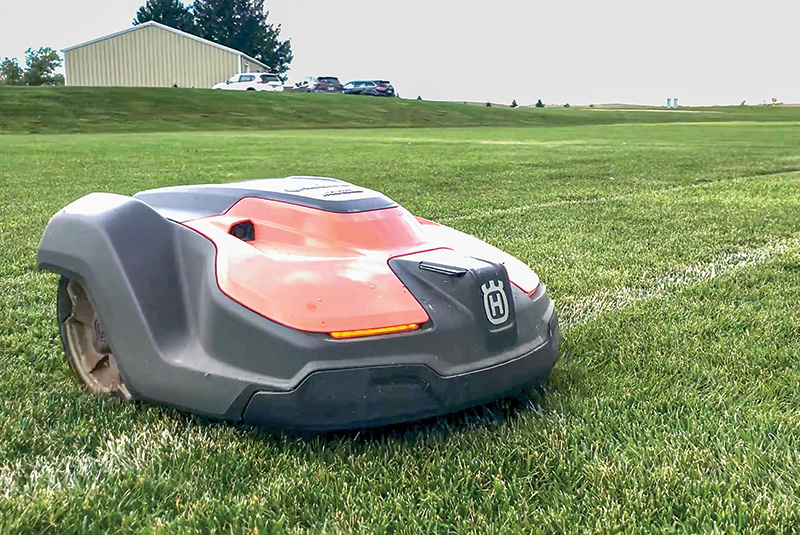
A robotic mower buzzes by on a turfgrass research plot at Iowa State University. Recent research has noted the advantages of robotic mowing versus traditional mowing. Photo by Darrell J. Pehr
Many golf course superintendents have welcomed the arrival of autonomous, robotic mowers, which bring the benefits of lower emissions, lower staff costs and — especially important when mowing near residential areas — lower noise levels than traditional, gas-powered mowers. As more of these cleaner, cheaper, quieter miracle machines are dispatched to our greens and fairways, what unknowns, pro or con, should we be considering?
Scientists, of course, are constantly studying the what-ifs of the world, and turfgrass researchers are no different, especially when it comes to robotic mowers, which have the potential to become one of the most transformational changes for golf maintenance in our time. The pace of research related to robotic mowers marches on, with a study published this spring looking at the response of Kentucky bluegrass to autonomous mowing. Researchers at the University of Padua, Italy, focused on this cool-season turf’s quality and morphological characteristics, comparing conventional mowing weekly at 1.5 inches (3.9 centimeters) to autonomous mowing daily at 1.3 inches (3.3 centimeters).
The study, conducted by the university’s Stefano Macolino, Alberto Novello and Cristina Pornaro, took place from autumn 2023 to spring 2024 at the university’s experimental farm. Researchers looked at visual assessments of turfgrass quality, normalized difference vegetation index (NDVI) measurements and analysis of various items, such as rhizome length, thatch depth, number of tillers and leaf area. Initially, they found turfgrass quality was better in the area mowed robotically, but that became less significant over time. They observed a thinner thatch layer, higher tiller density and greater leaf surface area in the robotically mowed areas.
“Kentucky bluegrass demonstrated satisfactory aesthetic quality and vigor under autonomous mowing during the cooler months,” says the study, which was published in April in the International Turfgrass Society Research Journal and can be found online at https://doi.org/10.1002/its2.70035.
“Turfgrass plants were able to adapt to a high-frequency mowing regimen by becoming denser and having a high number of tillers and leaves below the mowing height,” they note. “Turfgrass mowed with the autonomous mower showed reduced thatch production, leading to fewer maintenance practices and less disease incidence.”
The interest in the Kentucky bluegrass response to robotic mowers is expected to continue, with further research envisioned that would validate the results and focus on how KBG responds during summer months.
The study at the University of Padua is one of many looking at this new practice. At the University of Florida, researchers examined the impact on a warm-season turfgrass. P. Agustin Boeri, Alex J. Lindsey and J. Bryan Unruh tested St. Augustinegrass at the university’s West Florida Research and Education Center in Jay.
While recommended height-of-cut is 3.5 inches (9.0 centimeters), they had the robot mower set at 2.5 inches (6.35 centimeters), again mowing daily and comparing to traditional weekly mowing.
The 2018-2020 study showed robotic mowing produced better turfgrass quality and green cover in the winter and similar quality and cover during the rest of the growing season.
“Moreover, the turfgrass canopy was more uniform when maintained with the autonomous mower,” the study said. “The effect of autonomous mowers on turfgrass management aspects such as pest pressure, fertilizer rates, soil compaction and irrigation requirements in warm-season turfgrasses needs to be further investigated. Additionally, more research is needed to determine which component of the autonomous mower (i.e., height-of-cut, mowing frequency and/or blade replacement) led to increased turfgrass quality.”
Their study was published in August 2023 in HortTechnology and can be accessed online.
So, what can golf course superintendents take from these two studies?
First, it seems that the more robotic mowing is studied, the more positive aspects are found. Second, this fascinating new technology is sure to be the subject of many more studies as scientists seek answers to more questions. As the Florida researchers summed it up: Autonomous mowers “have the potential to make turfgrass management more sustainable by reducing energy consumption, gas emissions, dust and noise production.”
Darrell J. Pehr is GCM’s science editor.